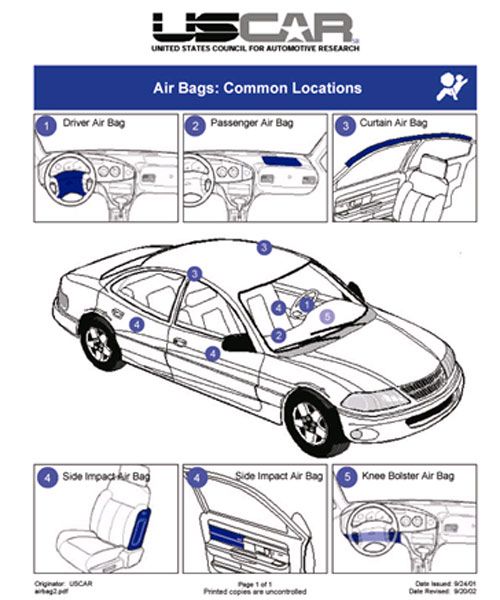The integration of airbags and air type devices in vehicles has dramatically transformed vehicle safety. They have been proven to save lives over and over again. But while air bags in vehicles may save civilian lives, they can be deadly to firefighters and first responders if not properly identified.
This article will highlight some basics about vehicle airbags, and with the use of video demonstrate the dangers of them at an emergency scene.
Airbags offer vehicle occupants additional safety beyond a seat belt during an accident. They are gas inflated nylon fabric constructed bags set off by a small detonation. The detonation is triggered by various possibilities such as deceleration, the angle of impact, force of impact, the severity, and seat occupancy sensors.
Once the system determines the accident has reached or exceeded a predetermined threshold, the system is activated. Within milliseconds, the system is fired with a pyrotechnic-like device that causes the nylon fiber bag to fill before the occupant strikes the vehicles interior framework.
Airbags are most often located in the steering wheel and dashboard, but can also be found in areas such as the doors, roofs, seat, or cushions. Airbag patents go back to the late 1960s, but research tends to show the first use of the air bags in vehicles occurred in the early 1970s.
The principle to save more lives has always been the same, but the technology has advanced significantly since the 1970s.
Airbag technology has since evolved to adjust for child occupants, level of severity of accidents, seat belt usage, size and position of occupant, location of accident, multi-stage inflation devices, and additional sensors.
Here’s how an airbag works:
The following chart provided by the United States Council for Automotive Research shows the common locations for airbag devices:
 |
Knowing these locations will aid first responders in operating at a vehicle-involved emergency. We must remember that airbag hazards are not only present at motor vehicle accidents. We must include airbag size-up during vehicle fire suppression operations as well.
The following video shows an airbag explosion near miss during a Moscow, Idaho, house fire:
We need to remember the following items when working on a vehicle with airbags:
- Wear full PPE while operating at an incident
- Conduct size-up to determine if a system is present
- Conduct size-up to determine locations of airbag systems
- Deployed airbags are not dangerous
- Undeployed airbags can be dangerous
- If vehicle is involved with fire, expect explosions with projectiles
The NHTSA recommends the following procedure when working with an undeployed system:
- Turn off the engine, and carefully disconnect both battery cables. Disconnect the negative cable first. The U.S. Fire Administration advises rescue personnel to disconnect the cables whenever possible, since cutting them can cause an electrical arc and fire. In a severe crash, make certain the battery case has not been penetrated with metal body parts that could recomplete the electrical circuit. Battery disconnect can be verified by attempting to turn on the headlamps and tail lights.
- Wait until the airbag system is deactivated. Check the Air Bag Deactivation Times chart to find out how long it takes for the backup system to completely deactivate. Some vehicles may take up to 30 minutes to deactivate, but most vehicles take 10 minutes or less.
- If there is a fire at the scene, use normal fire-extinguishing procedures, and then follow the guidelines above. (Expect explosions with projectiles when system under fire load)
The next video shows an airbag deployment during rescue operations:
And this final clip outlines some new car dangers including airbags, high strength metals, and hybrid wiring
The key to safe operation around airbag-equipped vehicles is understanding the nature of airbags and the potential safety hazards that exist. This knowledge will be critical when you conduct your size-up. Size-up will allow you and your crew to operate safely around any vehicle involved emergency scene.
Related resources:
Emergency Rescue Guidelines for Air Bag Equipped Vehicles











